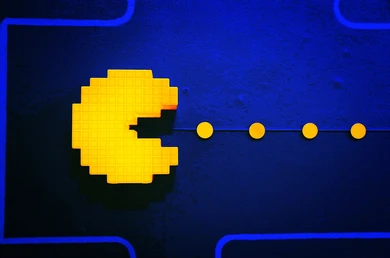Pac-Man was released in 1980 by Namco which revolutionized the way people play games. Pac-Man created by Japanese video game designer Toru Iwatani, has gained fame due to its uncomplicated yet engaging game where a player navigates through a maze full of ghosts ducking and eating away at dots. In order to mark the 30 years of Pac-man, Google Ceiling painted a playable tribute to Pac-man in the year 2010 that managed to entertain millions of people. Having been created ages ago, Pac-Man has grown and developed within the years and has contributed to the gaming and pop culture of the society extensively.
The Origins of Pac-Man
Creation and Concept
Pac-Man’s conception was driven by Toru Iwatani’s goal to design a game with universal appeal. In an era dominated by space shooters, Iwatani sought to create something different, especially to attract women. The concept came to him over a pizza; with a single slice missing, the pizza looked like a mouth—thus the circular design of Pac-Man, known in Japan as “Puck-Man” based on the Japanese word “paku,” meaning “to chomp”
Game Mechanics and Innovation
Released in Japanese arcades in 1980, Pac-Man introduced players to a unique world of maze-chasing fun. Unlike the violent, space-themed games of the time, Pac-Man was visually engaging and inviting, featuring bright colors and characters that appealed to all ages. The gameplay was straightforward: players control Pac-Man, navigating through a maze filled with pellets and power-ups, avoiding the four ghosts—Blinky, Pinky, Inky, and Clyde. Each ghost had its unique movement pattern, adding an element of strategy and unpredictability to the game, which was part of what made it so addictive
The Name Change from Puck Man to Pac-Man
Initially released as Puck Man, Namco changed the name to Pac-Man when it launched in North America to avoid the potential vandalization of arcade cabinets where “Puck” could easily be modified to something profane. This rebranding decision turned out to be a wise move, helping Pac-Man gain traction and establish itself as a global phenomenon.
The Rise of Pac-Man and Its Cultural Impact
Success and Popularity
Pac-Man became an instant hit in arcades, eventually spreading to homes as it was ported to various consoles. Over 100,000 arcade machines were sold in the U.S. alone, with fans lining up to play the game, competing for high scores, and even attempting to “beat” the game. Pac-Man holds multiple Guinness World Records, including “Most Successful Coin-Operated Game,” and the character was among the first video game mascots to gain worldwide recognition.
Iconic Characters and Visuals
The simplicity of Pac-Man’s design made it universally recognizable. The four ghosts—each with its personality and unique movement style—added a layer of charm and challenge. Blinky, the “chaser,” followed Pac-Man relentlessly, while Pinky, Inky, and Clyde each had distinct AI that required players to devise different strategies. This individuality gave each game a sense of newness and thrill.
Expansion into Merchandise and Media
Pac-Man was more than just a game; it was a cultural phenomenon. Its influence extended into merchandise—posters, toys, and T-shirts adorned with Pac-Man and ghost designs. The game even inspired music, notably the hit song Pac-Man Fever, further embedding itself into the 80s culture. In addition to merchandise, Pac-Man inspired cartoons, a TV series, and even board games, proving that the character was more than just an arcade staple.
Celebrating 30 Years: Google’s Interactive Doodle
Google Doodle’s Concept and Reception
On May 21, 2010, Google unveiled an interactive Doodle that allowed users to play Pac-Man directly on the search page. This Doodle was created in honor of the game’s 30th anniversary, reviving nostalgic feelings for long-time fans while introducing new players to the classic. The response was overwhelming; the Doodle reportedly cost businesses over $120 million due to lost productivity, as millions spent time chasing ghosts during work hours
Impact on Businesses and Nostalgia for Fans
The Google Doodle was not just a homage; it sparked a global Pac-Man revival. Within 48 hours, users collectively spent over 500 million hours playing the Doodle. Its popularity demonstrated Pac-Man’s enduring appeal and was a reminder of the game’s cultural impact. The Doodle introduced younger generations to the retro game while reigniting nostalgia for those who had grown up with the arcade classic
Gameplay Legacy: High Scores and the “Perfect” Game
High Scores and Competitive Gaming
Since its release, Pac-Man has inspired competitive gaming, with players aiming to achieve the highest possible scores. In 1999, American gamer Billy Mitchell reached the perfect score of 3,333,360 points, a feat that required eating every dot, ghost, and bonus item on each of the game’s 256 levels without losing a single life. This high score record stands as a testament to Pac-Man’s competitive appeal and the dedication of its fans.
The Infamous Level 256 “Kill Screen”
One of the game’s most infamous features is the “kill screen” on level 256. Due to a programming glitch, the right side of the screen fills with random symbols and becomes unplayable, preventing players from progressing. This quirk has become a part of Pac-Man lore and serves as a challenge for players attempting a perfect game. Although level 256 was never meant to be completed, it has added a unique mystery to Pac-Man and challenged gamers to see how far they can get.
The Evolution of Pac-Man Over the Decades
Game Ports and Adaptations
Over the years, Pac-Man has been adapted to nearly every gaming platform, from consoles and PCs to mobile devices. Each adaptation aimed to preserve the original charm while introducing new gameplay elements. Pac-Man has remained relevant through these adaptations, proving its timeless appeal and ability to entertain players of all ages.
Modern Pac-Man Games and Spinoffs
Namco and Bandai have continued to expand the Pac-Man franchise, releasing spinoffs like Pac-Man Championship Edition and Pac-Man and the Ghostly Adventures. These games modernize Pac-Man’s gameplay, adding new mazes, power-ups, and challenges while keeping the core mechanics familiar. These updates allow Pac-Man to remain fresh and relevant in the constantly evolving gaming landscape.
Cultural Impact: Pac-Man in Pop Culture and Academia
Pac-Man as a Cultural Symbol
Pac-Man became more than just a video game; it became a symbol of 80s pop culture. Its impact was so widespread that it influenced other media, including television, films, and even business practices. For example, the term “Pac-Man defense” is a business strategy used during hostile takeovers, highlighting how deeply ingrained Pac-Man is in modern culture.
Pac-Man in Academic Research and Math
Beyond pop culture, Pac-Man has even found its way into academic fields. For example, in mathematics, “Pac-Man renormalization” is a technique used in advanced physics. This influence speaks to the game’s iconic status and shows how its mechanics have inspired creative thinking beyond the gaming world.
Global Appeal and Enduring Legacy
One of Pac-Man’s most remarkable qualities is its universal appeal. People from different cultures, age groups, and backgrounds have enjoyed Pac-Man for decades, thanks to its simplicity and charm. Few games have achieved such widespread popularity and maintained it for as long as Pac-Man has, and this is why it remains a timeless classic
Conclusion: Pac-Man’s Lasting Legacy
Forty years after its release, Pac-Man is more than just a game; it’s a cultural icon. Its simple yet addictive gameplay has kept it alive across generations, cementing its place in gaming history. The 30th anniversary Doodle from Google is a testament to Pac-Man’s impact, introducing the game to new generations and allowing long-time fans to relive the joy of arcade days. As Pac-Man continues to inspire new games, characters, and players, it stands as a reminder of gaming’s humble beginnings and the timeless appeal of simple yet engaging gameplay.
Also Read: 14344 Meaning : A Modern Code for “I Love You Very Much”

